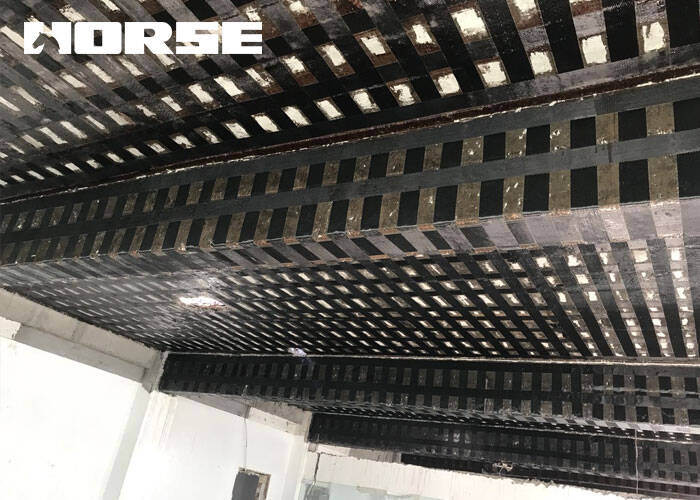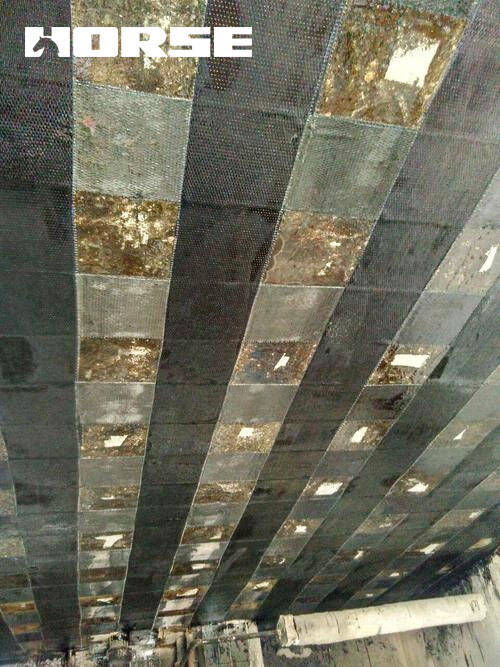Solutions
Horse Construction offers full range of structural strengthening materials with technical supports, documentation supports, products supports, project supports.
Application and Countermeasures of CFRP in Structural Strengthening

Common problem types of CFRP in structural strengthening and retrofitting
In the process of CFRP reinforcement construction, the preventive measures that the reinforcement quality does not meet the requirements of the design and construction specifications are mainly as follows:
(1) The quality of CFRP or building structural glue cannot meet the design requirements;
(2) The surface polishing treatment of reinforced concrete structures cannot meet the specification requirements;
(3) The construction method of building structural adhesive ratio, mixing, and pasting CFRP cannot meet the requirements of construction specifications;
(4) Prevention and treatment methods of CFRP from damage before and after use;
(5) The management team is not clear about the division of labor, the responsibilities are not clear, and the operators have poor quality awareness;
Prevention and countermeasures
Strictly control the quality of material procurement
(1) Appointment and responsibilities for procurement In order to ensure that the quality of CFRP and building structural adhesive meets the requirements of design and specifications, professional and technical personnel should be arranged to be familiar with design drawings and relevant reinforcement construction specifications before construction. And put forward the material plan of CFRP and building structural adhesive according to the design requirements of the drawings. After being reviewed by the technical person in charge, it will be submitted to the material personnel for procurement. The quality of the material must be purchased in strict accordance with the specifications, models, technical indicators and parameters of the design drawings.
(2) Product quality factory inspection, select professional manufacturers with mature technology, good reputation, and meet quality requirements, and provide quality assurance materials, certificates, and documents with the products.
(3) CFRP and building structural adhesives shall be witnessed and sampled before use. Select a qualified laboratory for sampling and re-inspection, and use it only when the quality meets the design and specification requirements, and seal the sample.
(4) Strictly follow the instructions for the use of CFRP and building structural adhesives. If you encounter unqualified or damaged carbon fiber cloth and structural adhesives, you should replace the unqualified materials in time.
Quality Control of Surface Grinding Treatment of Concrete Structure
(1) Treatment of block scars on structural surface. First, chip off the loose concrete block, and brush off the corroded layer with a steel wire brush, and then use compressed air to remove the floating dust on the surface. For large-area inferior layers, use high-strength epoxy mortar to repair and cure for 3 days.
(2) The surface layer of the structure is polished in detail. Impurities such as floating slurry and oil stains on the surface of the concrete should be smoothed, especially the convex parts of the surface. In particular, the yin and yang corners of the beam and the overlapping parts should be treated well. Otherwise, it is easy to form an isolation layer between the carbon fiber cloth and the structural surface, or there may be pits, resulting in hollow drums or bubbles on the bonding surface of the carbon fiber cloth.
(3) After the concrete surface is chiseled, repaired, and polished, clean the area to be pasted with acetone.
(4) The treatment of the yin and yang corners and overlapping parts of the beam should meet the requirements of the specification.
(5) Use light to check the flatness and effect of the polishing, and carry out the quality acceptance of the polishing process.
The use of building structural glue and the quality control of carbon fiber cloth paste
(1) Technical confession Before construction work, technical confession should be made according to the design drawing requirements, construction specification requirements and the above-mentioned material product instructions for the use of building structural adhesive and the method of pasting carbon fiber cloth. Perform on-site practical operations to the construction personnel, so that everyone involved in the construction is familiar with the use of building structural adhesives and the construction methods and technical essentials of carbon fiber cloth paste.
(2) Strictly standard-model samples, item by item up to the standard acceptance before large-area paste construction. Instructed by technical personnel, all construction personnel participated, and a component with a small paste area was selected for on-site paste test. After the test results are qualified and all construction personnel have mastered the construction method, large-area paste construction is carried out. Carry out the responsibilities according to the group and the person, strictly control the quality of the process, and check and accept the standard item by item.
(3) Technical requirements for building structural glue mix ratio and mixing
① The two groups of components of the building structural adhesive should be measured and proportioned in strict accordance with the quantity ratio required by the instruction manual, and the mixing should be carried out in the order of delivery. Proportion should be followed during construction, strict measurement, and error control.
②Before each combination, use a thin stick to properly mix the glue in the packaging barrel, which is beneficial to ensure the paste effect after the structural glue is mixed. It should be noted that A and B glue cannot be mixed with the same thin rod.
③When the structural glue is stirred, it should be stirred evenly. It is very important to mix and stir the two-component structural glue uniformly. The greater the viscosity of the structural glue, the longer the stirring time should be, and it should not be less than 10 minutes. Special agitator should be used for glue dispensing.
④ Avoid mixing other impurities when mixing the structural adhesive, otherwise the quality of the structural adhesive will be affected.

(4) CFRP pasting technical requirements
① The carbon fiber cloth must be soaked with the adhesive structural glue, so that the structural glue can fully penetrate the gap between the carbon fiber monofilaments as much as possible to improve the performance of working together between the monofilaments.
②The soaked carbon fiber cloth is gently pressed and pasted to the required position by hand. Use a rubber roller to compact evenly and smoothly along the fiber direction, so that the structural glue overflows from both sides, and ensure that the carbon fiber cloth and the structure are dense and void-free, or the effective bonding area is not less than 95%. After the fingers are dry, the second carbon fiber cloth can be pasted in the same way as the first. Note: The lap length of CFRP is generally 100mm, and the ends are fixed with transverse carbon fiber cloth.
③Folding the carbon fiber sheet at a right angle along its fiber direction will cause stress concentration and affect its strength. Grinding the corners into rounded corners during construction can reduce stress concentration, and the strength of CFRP is basically not affected.
④ The structural glue used in the pasting construction should be used up within the time specified in the manual when the self-mixing is completed, otherwise the reinforcement quality will be affected.
Prevention and treatment methods of carbon fiber cloth from damage before and after use
(1) In the carbon fiber cloth construction process, in order to ensure that the pasted carbon fiber cloth is not damaged, the construction personnel should take care to protect the pasted carbon fiber cloth from collision or pollution.
(2) Enclosure and closed construction of the work site.
(3) For the reinforcement of basement beams and slabs, ventilation and adequate lighting should be strengthened.
(4) The upper and lower floors of the structure must not be affected by construction vibration loads and construction dust.
The management team is unclear, the responsibilities are unclear, and the operators have poor quality awareness
(1) Establish a professional reinforcement project leadership team and establish and improve various responsibility systems. Achieve clear division of labor and clear responsibilities.
(2) Only technicians with professional knowledge can operate. Select personnel with high quality awareness, good technical level, and strong sense of responsibility to work with certificates. Otherwise, the process quality is difficult to guarantee.
(3) The actual process is the ‘‘Three Inspection System’’ to strictly control every quality.
(4) Do a good job in the division of labor and cooperation, timely acceptance and certification of special personnel and hidden procedures
Concluding remarks
This article summarizes the quality problems that are likely to occur in the construction of CFRP reinforcement and reconstruction projects, and puts forward some prevention methods and countermeasures according to the possible problems. The prerequisite for the quality of reinforcement is: there should be "prediction, prevention, and pre-control" ideas and measures to ensure the construction quality of CFRP reinforcement in structural transformation.
You can find anything here you are in need of, have a trust trying on these products, you will find the big difference after that.

High strength, unidirectional carbon fiber wrap pre-saturated to form a carbon fiber reinforced polymer (CFRP) wrap used to strengthen structural concrete elements.

High strength, unidirectional carbon fiber fabric pre-saturated to form a carbon fiber reinforced polymer (CFRP) fabric used to strengthen structural concrete elements.

High strength, unidirectional carbon fiber sheet pre-saturated to form a carbon fiber reinforced polymer (CFRP) sheet used to strengthen structural concrete elements.